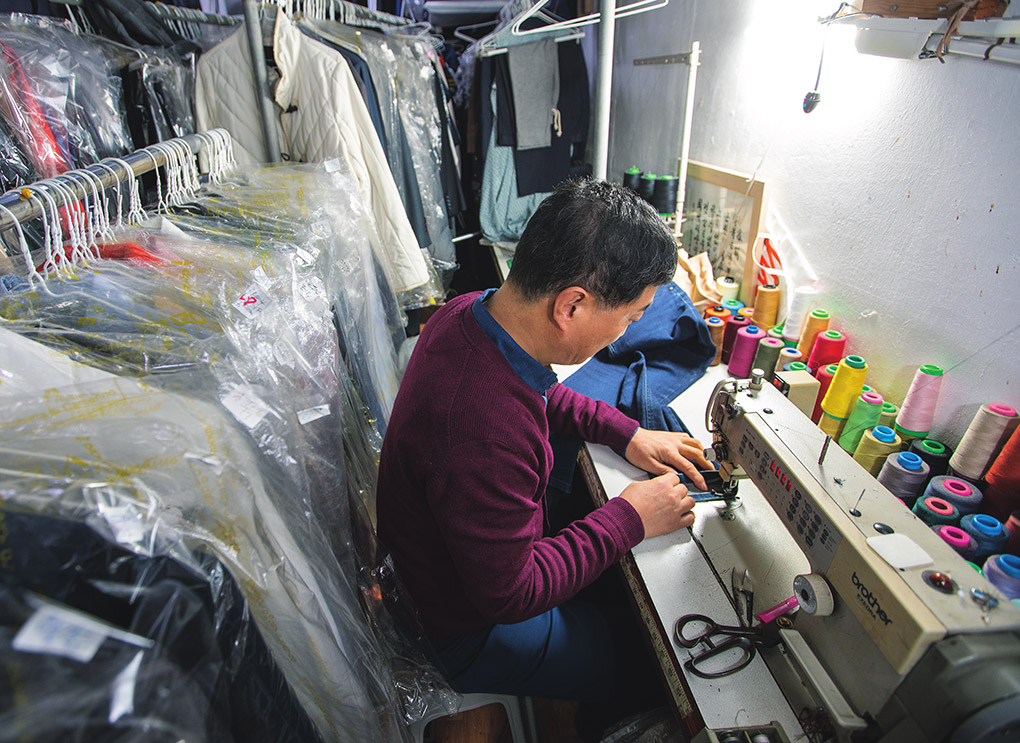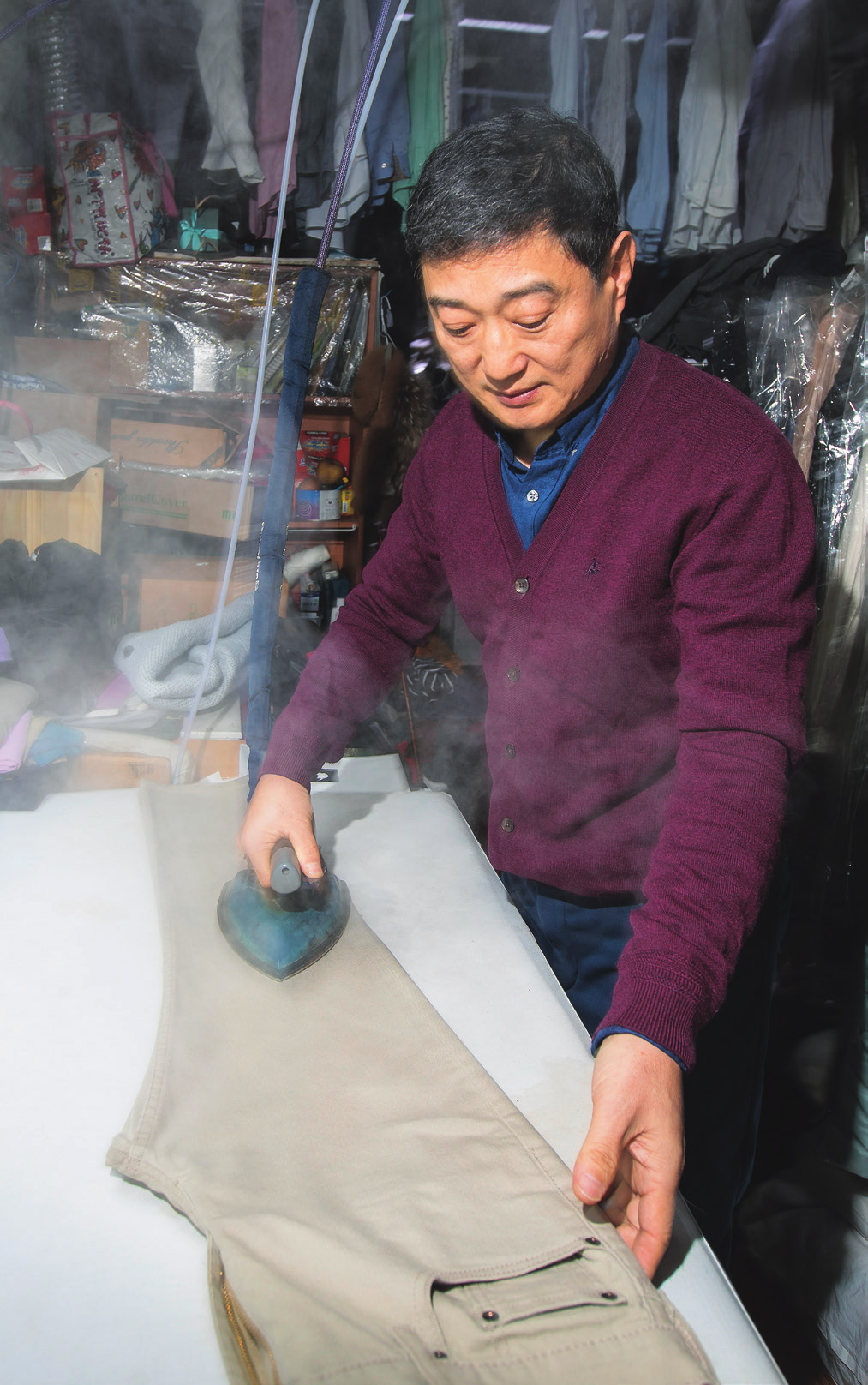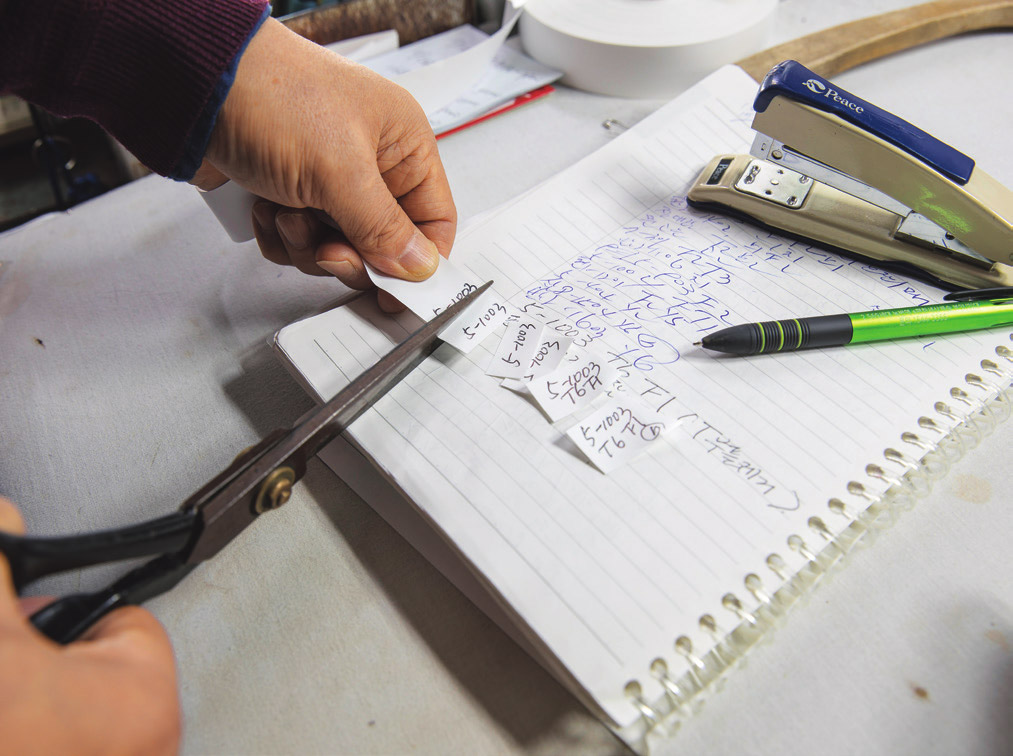Coarse hands move nimbly between rising plumes of white steam. Seconds later, a rumpled piece of clothing is reborn, neat and smooth. Handing their clean, warm clothes back to his customers, an easy smile spreads across Oh Ki-nyeong’s face at his neighborhood dry cleaning shop.

Oh Ki-nyeong, the owner of Hyundai Cleaning in Mapo District, Seoul, has 14-hour workdays at his 26 sq. meter shop. He is especially busy in the spring, when most households take out their spring cloths and stow their winter clothes at the same time.
“Tearing off a piece of freshly baked bread with my hands; stacking a pile of folded underwear neatly in my drawer; the feel of a brandnew shirt slipping over my head, its scent of clean, new cotton – these are moments when I feel a small but certain happiness,” writes author Haruki Murakami. Every country, it seems, has a way of expressing this sort of peace and the way to achieve it. In Denmark, there is “hygge”; in Sweden, “lagom”; in France, “au calme.” More recently, “sohwakhaeng,” an abbreviation of the phrase “small but certain happiness,” has entered the Korean lexicon.
Surely, the dry cleaner’s – that one place in every neighborhood alleyway that seems always to be open, emitting its white steam – must be a purveyor of the sort of warmth that transcends nationality or race.
At Hyundai Cleaning, a neighborhood dry cleaner’s on Shinsu-ro street in the Mapo District of Seoul, owner Oh Ki-nyeong starts his day at 8 a.m.
“When I get to work, first I organize and sort the laundry by type and then wash it. Once that work is done, I gather all the clothes that have come in for alterations and work on those. Then comes the ironing. At 9 p.m. it’s time to go make the deliveries. By the time I’ve done the rounds of the five or so apartment complexes around here, it’s usually close to 10 p.m.
“Spring is the busiest season of the year. With every household taking out their spring clothes and stowing their winter clothes all at the same time, the laundry overflows. So in spring, there’s really no start or end to my workday. I’ll work until 1 or 2 a.m., ’til I pass out asleep, then I’ll get up and work again for as long as I can stand it.”
There’s a lot less work these days, due to changing circumstances. In previous years, Oh would make 40 deliveries daily. Now, there are no more than 10. Still, his 8 a.m. to 10 p.m. workday remains unchanged, most of it spent standing.
One elbow is deformed, the consequence of ironing with one arm for so many years. “It’s an occupational disease – no way to heal it completely, even with steady exercise,” he explains.

Oh brings the gratitude he feels for his customers to every piece of clothing that he handles. Largely catering to regulars, his shop has been a neighborhood fixture for 20 years.
Getting Established
Oh started learning his trade in his early twenties, working at a clothing factory where he first brushed thread and ripped seams, and eventually mastered his tailoring skills. He set out to found a factory of his own at around age 30. He operated it for about five years, before becoming a casualty of the 1997 Asian financial crisis.
“The number of orders plummeted, so much so that we only had enough work for two, three days a week. There was just no way to pay my employees. There was nothing to be done but shut down the factory. My youngest brother was running a dry cleaner’s in Yongin then, so I went to take a look and thought maybe I should try it, too. After all, it’s the kind of work you can do even as you get older, so long as your body holds out.
“It so happened that a friend of my wife’s was also running a dry cleaner’s. My wife and I worked there together to learn the necessary skills. We worked for three months without pay, day in and day out, learning various techniques, how to run the machines, and so on. Laundry techniques are different, depending on the fabric. My experience making clothes at the factory turned out to be a big help.”
Oh had some hit-or-miss learning experiences. His first location was in Guro-dong, a section of Guro District, where dress-making and textile manufacturing once thrived.
Oh’s lack of experience translated into a lot of effort without much profit. Dealing with all types of people would also upset him frequently. Within just a few months, he moved into the retail section of a new apartment complex. At the time, there was an unwritten no-compete rule. With no other dry cleaner present, Oh ended up handling all 1,300 households in the complex. He lasted six months before throwing up his hands; it was just too much work. Looking for his next location, he told himself not to be greedy.
“Mapo is actually my home neighborhood. Back when I was first trying to set up a dry cleaner’s, this place had no apartments yet. By the time I’d sold my second shop, though, a bunch of apartments had been built in the meantime and there just happened to be an available space, so I took it. Now it’s been about 20 years since I set up shop here.”
Despite the reduced volume in recent times, the workday still isn’t easy. Ever since his wife’s health began to decline, Oh has taken over all of the daily operations on his own.
Filled with stacks and stacks of laundry and packed with all kinds of sewing machines and the like, the shop is a mere eight pyeong (26.4 sq. meters). Even when there’s time for a short break, there’s no space to lie down – so he rests in a chair.

New technology can help sort orders, but Oh refuses to deviate from sorting and checking handwritten tags for each order, one by one.
Changing Circumstances
Younger generations tend to favor easy-to-use laundry apps, or entrust their clothes to relatively cheaper and more familiar franchises. Meanwhile, as people have been going out less and working from home more due to the COVID-19 pandemic, less laundry needs to be done. And because dry cleaning work itself is taxing, it’s increasingly difficult to find anyone interested in learning how to do it.
Indeed, neighborhood dry cleaning shops like Oh’s place are gradually disappearing. Once the current owners have aged out of being able to do the work, they tend to close their doors for good.
Still, the fact remains that Oh is a master craftsman, doing his utmost for each and every patron. Most of the customers who seek out his shop are homemakers in their forties and fifties, long-term regulars. They express honest joy when they are handed their clothes, clean as new, and sometimes show their appreciation with small gifts of pastries or fruit. There are, of course, unpleasant customers as well.
Some claim there are stains that weren’t there before. And some are simply rude without cause. “There are people who talk down to me. It’s like they think they can speak to me however they want just because I do this kind of work. Those people are the hardest to deal with. I have to be very clear that if they aren’t satisfied, it’s fine for them to go someplace else. Otherwise, it just causes me too much stress.”
After so many years on the job, Oh has seen his fair share of memorable individuals, too. One forty-something customer, a man, would regularly bring in a mesh bag stuffed with everything from underwear to shirts and pants, even towels. Thanks to those still damp towels, the stench, of course, was pretty bad. Then one day, when the shop was closed, he took his whole load someplace else – only to come back later and complain that they charged far too much. “Now do you see?” was Oh’s reply.
He has now learned and mastered the art of not letting people hurt his feelings. After all, if a customer is unreasonable, he can just turn them away, and the good customers that always surround him make up for it. When all is said and done, he is only sorry he can’t do more for the good customers.
Wrestling with clothes all day long, it’s only natural that Oh’s sensitivity to fashion trends has become honed. When there’s an uptick in the number of customers coming in to tailor a new outfit, he thinks, “This style must be in fashion these days.” And since the proper washing technique for a garment depends on the material, it’s essential that he studies and stays informed. When he has time on the weekends, Oh visits clothing stores to keep up to date with the styles and pricing of current merchandise.
Hoping against hope that these difficult times will soon give way to the return of more ordinary days, Oh lifts his heavy iron once again to provide his customers one small but certain happiness.
A Master’s Efforts
In the past, people wore a lot of clothes that needed to be dry cleaned. Today, there are more varieties of functional clothes, such as different kinds of sportswear. Preserving their functionality requires shorter cleaning times and neutral detergents. Clothes can be ruined if one doesn’t know the specific requirements.
But to work Monday through Saturday and then spend Sunday going out to look at more clothes, does Oh have time for any other hobbies? At this, he smiles wide and pulls out a small notepad.
“I’m about to complete a cross-country bicycle trek along various cycling routes. Each course has a booth, and when you pass through, they give you a stamp. For a while I went every Sunday. Go early in the morning, race on my bicycle, and take the bus back home. Taking a long course and finishing it just a little bit at a time. I only have one stretch left now. It’s a way to get some exercise and some spiritual healing, too, on my day off – my greatest pleasure.”
And with that, hoping against hope that these difficult times will soon give way to the return of more ordinary days, Oh lifts his heavy iron once again to provide his customers one small but certain happiness.